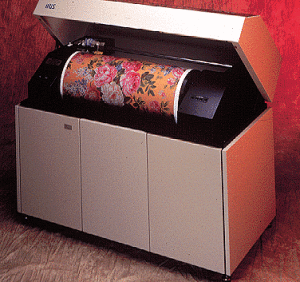What are your aims in your work right now?
My primary aim is to keep exploring—I think exploration and discovery are at the heart of the art-making process. I’m interested in color contrast and relationships—how colors respond to each other in the painting.
My paintings tend to fall into several different themes, which I’ve been exploring over a long period of time. Some are more reflective, more still. The Inexteriors series is like that—it comes from ideas about impossible architectural spaces, and seeing from multiple perspectives at the same time. Sometimes these spaces are inhabited by indistinct figures—sometimes not. I think of them as still spaces that are charged with a lot of potential energy. The Minivan Series is like that, too, although the spaces are automotive rather than architectural.
On the other hand, the Patterns in Motion series are semirepresentational, very dynamic, with a lot of movement in the shapes and sometimes literal movement, when I work on loose canvas. This series is where I tend to work out ideas about life and power, as well as sort of wild and intricate color combinations and the movement you get from nonrepetitive patterns. My most recent series, Composite Rhythms—all abstracts on paper—has a lot in common with that in terms of color and pattern and relationships.
How have your ideas changed over time?
The ideas for each of the different series change and grow over time but I keep them all going simultaneously. And the medium has changed. When I first started painting, I used oils and stuck to that for a long time. Then when I got pregnant with my first child, I switched to acrylics, which is truly a completely different medium—the palette is different, the surface is different, the possibilities are different. So I basically learned to paint again from scratch, to understand acrylic paints and mediums, and what you can accomplish with them. I started adding collaged elements, like different kinds of paper and string, which acrylic is very good for. And I started painting on loose canvas again, which you can do with acrylics but not with oils—something I discovered the hard way back in college! A few years ago, I moved to a studio outside of my house, and I started painting in oils again and just loving it. So now I do both.
Which artists do you consider influences?
I always find that question hard to answer, and in a way I really don’t want to think about it too much. There are so many artists that I love for so many different reasons—but I’d be very reluctant to draw any kind of parallel between their work and mine. Sometimes people tell me “Oh, your work looks like so-and-so” and I don’t see it all. That doesn’t mean their perception is not valid, just that I don’t see it and I don’t find it helpful to look for it.
I’ve said this many times before, but I think, in the end, what making art is about exploring and discovering. You’re hacking your way through the jungle, and sometimes you encounter another artist in the same part of the jungle and sometimes you don’t. Is that an influence? Or is that just dealing with the same kinds of things? It’s like meeting up with a friend in an unexpected place—you didn’t go there because they were going to be there or had been there. But you both ended up there for your own reasons.
![Marcia Santore, Inside Mothers Are Dancing, oil paint on canvas, 36 x 48 inches]()
Marcia Santore, Inside Mothers Are Dancing, oil paint on canvas, 36 x 48 inches
How did you first become interested in art?
I think I was born interested. Being an artist was the only thing I really seriously considered doing—although being an astronaut or a Friendly’s waitress had their moments when I was really little. My parents had a friend from college, Robert George, who was an abstract painter from Southern California. We had a lot of his work in our house, along with a lot of art books, and he was very encouraging—always making sure we had materials. So I always had a role model—proof that being an artist was a thing. We also traveled a lot, and saw a lot of art along the way. And my dad was a musician, so the arts in general were just how life was. And still is.
How long have you been involved with WCA?
The first WCA show I was in was Personal Icons in 2003 at what was then the Franklin Pierce Law Center in Concord. I joined the exhibitions committee (technically) around 2007 and did the prospectuses and some news releases for the shows. After a couple of years, I thought I should probably show up for a meeting, and at the first one I attended, Edie Weiler talked me into chairing the exhibitions committee, which I did for a couple of years. I’m still on the exhibitions committee, and I have learned so much from that experience. I’ve just started working with the national WCA exhibitions committee, which seems like a great way to pay forward on all the mentoring and professional development that I’ve received from this organization.
What important projects are coming up for you in 2017?
I have a busy year, first curating a show of small abstracts at Twiggs Gallery, called A Little Abstracted in April and May. You’re in that one! Then in the fall, I have two solo exhibitions happening at the same time, which is either really good luck or really bad planning. Patterns in Motion will be at the Stamford Art Gallery at the University of Connecticut–Stamford, and Inexteriors will be at the O’Brien Art Gallery at Roane State Community College in Tennessee. They’re both from late October through December, roughly.
Do you have advice about how to get a show?
Sure! Keep your resume and website up to date. Only about half of our WCA/NH artists have a link to their website or Facebook page from the wcanh.org website. Everyone should do this.
Also, you need really good digital images of your work with high resolution for print and low resolution for online. You also need a coherent portfolio of about 20 images. Since I work in different series, I need a coherent portfolio for each series. Do some research, so you can figure out which venues are most likely to show your kind of work, and then start contacting them—in person, if you can—I did a lot by email.
You have to expect a lot of rejection, and just no response—which I guess is rejection by silence. If you’re in the arts, you’re going to experience a lot of rejection and you just have to keep putting the work out there. It’s not pleasant but it’s part of the job, part of being an advocate for your work. You only need one “yes” but you have to wade through a lot of “no”s to find it. This particular time, I got a better response than I expected so I stopped sending my portfolio out so I can focus on finishing work for the shows. But I am starting to think about 2018 and beyond.
Learn more at www.marciasantore.com
Featured image: Marcia Santore, There Are Many Other Legends, acrylic paint on canvas, 30 x 40 inches
Kate Higley is the current President of WCA/NH. You can see her work at www.katehigleyart.com/


























